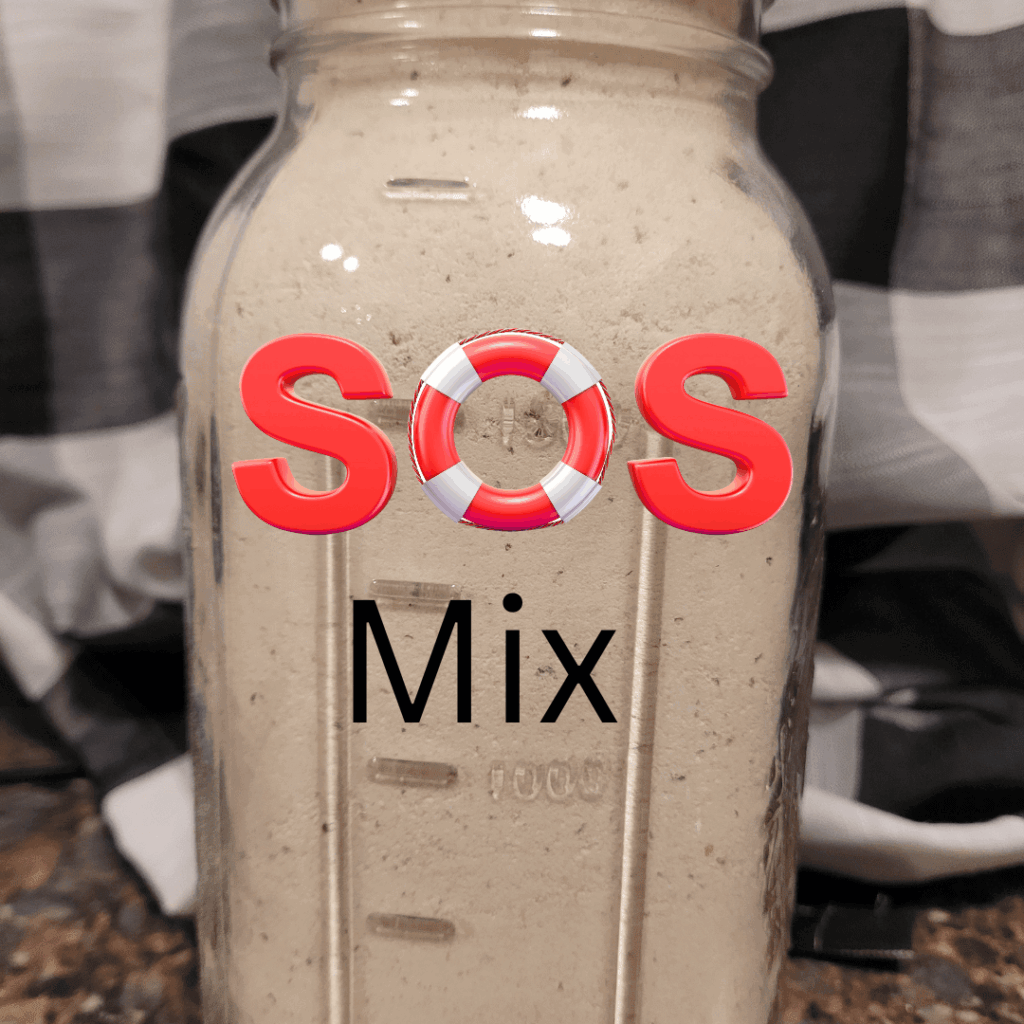Stay hydrated when it matters most with expert emergency water prep tactics. Learn how to store, purify, and secure safe drinking water for any survival situation.
Water is life, and in an emergency, having a safe and reliable supply can mean the difference between staying comfortable and facing a serious crisis. Yet many people overlook proper water preparation until it’s too late. In Thirsty for Survival, I’ll walk you through practical tactics for storing, purifying, and managing emergency water so you and your loved ones are always ready. From simple at-home solutions to long-term storage strategies, this guide ensures your survival plan includes one of the most critical resources: clean water.
This is a pinnable post. Tap or hover over any image in this post to pin to your Pinterest Boards.
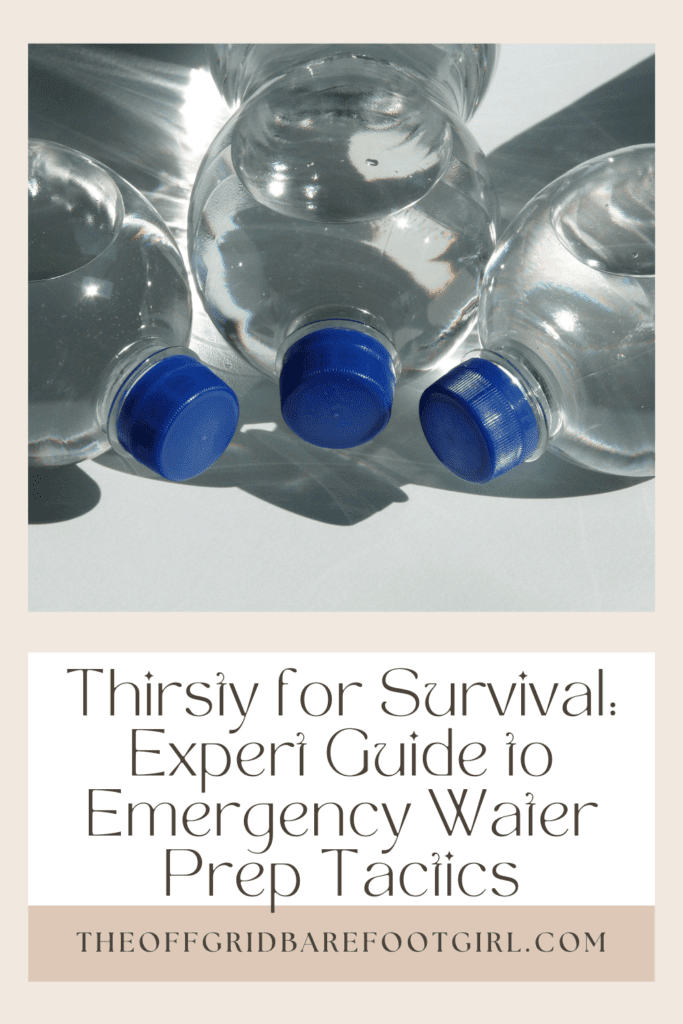
Importance of Emergency Water Preparedness: Emergency Water Prep Tactics
Understanding the Critical Role of Water in Emergency Situations
In a crisis situation, water becomes your best friend. Water is essential for our survival and in emergency situations. From drinking and cooking to personal hygiene and medical needs, water plays a critical role in keeping us alive and kicking. It’s the ultimate VIP in the world of emergency preparedness.
Also, when it comes to emergency situations, water plays a critical role that is often overlooked. Whether it’s a natural disaster or an economical crisis, access to clean and safe drinking water becomes paramount for survival. In times of such emergencies, people might find themselves without access to running water due to infrastructure damage or contamination. Understanding the importance of having an emergency water supply is crucial in these situations. Water not only keeps us hydrated, but is also necessary for cooking, cleaning wounds, and maintaining proper sanitation.
Additionally, having enough water on hand can prevent dehydration and other health issues that may arise during emergency situations. So next time you’re preparing for unforeseen events, don’t forget to prioritize adequate water storage – it could be the difference between life and death when disaster strikes!
Recognizing the Potential Risks and Scarcity of Water: Emergency Water Prep Tactics
Have you ever stopped for a moment and thought about the potential risks and scarcity of water? It’s not something that typically pops into our minds on a daily basis, but it’s definitely worth considering. With the ever-increasing global population, demand for water is on the rise, while its resources remain limited. Climate change also poses a significant threat to our water supply, as droughts and extreme weather events become more frequent.
Furthermore, pollution from agriculture, industry, and inadequate waste management compromises the quality of our freshwater sources. While we may take water for granted in our everyday lives, it’s essential to recognize these risks and work towards sustainable practices like conservation and responsible usage. Only through proper understanding and action can we ensure a sufficient supply of clean water for both ourselves and future generations.
Water scarcity can strike when you least expect it. Natural disasters, like hurricanes, tornadoes, or earthquakes, can disrupt water supply systems faster than a Kardashian can break the internet. And let’s not forget about human-made emergencies – your friendly neighborhood burst pipes or contaminated water sources. In these situations, you can find yourself desperately searching for water. So, it’s absolutely crucial to be prepared for such scenarios to ensure you don’t find yourself high and dry.
Understanding Water Needs in Emergency Situations: Emergency Water Prep Tactics
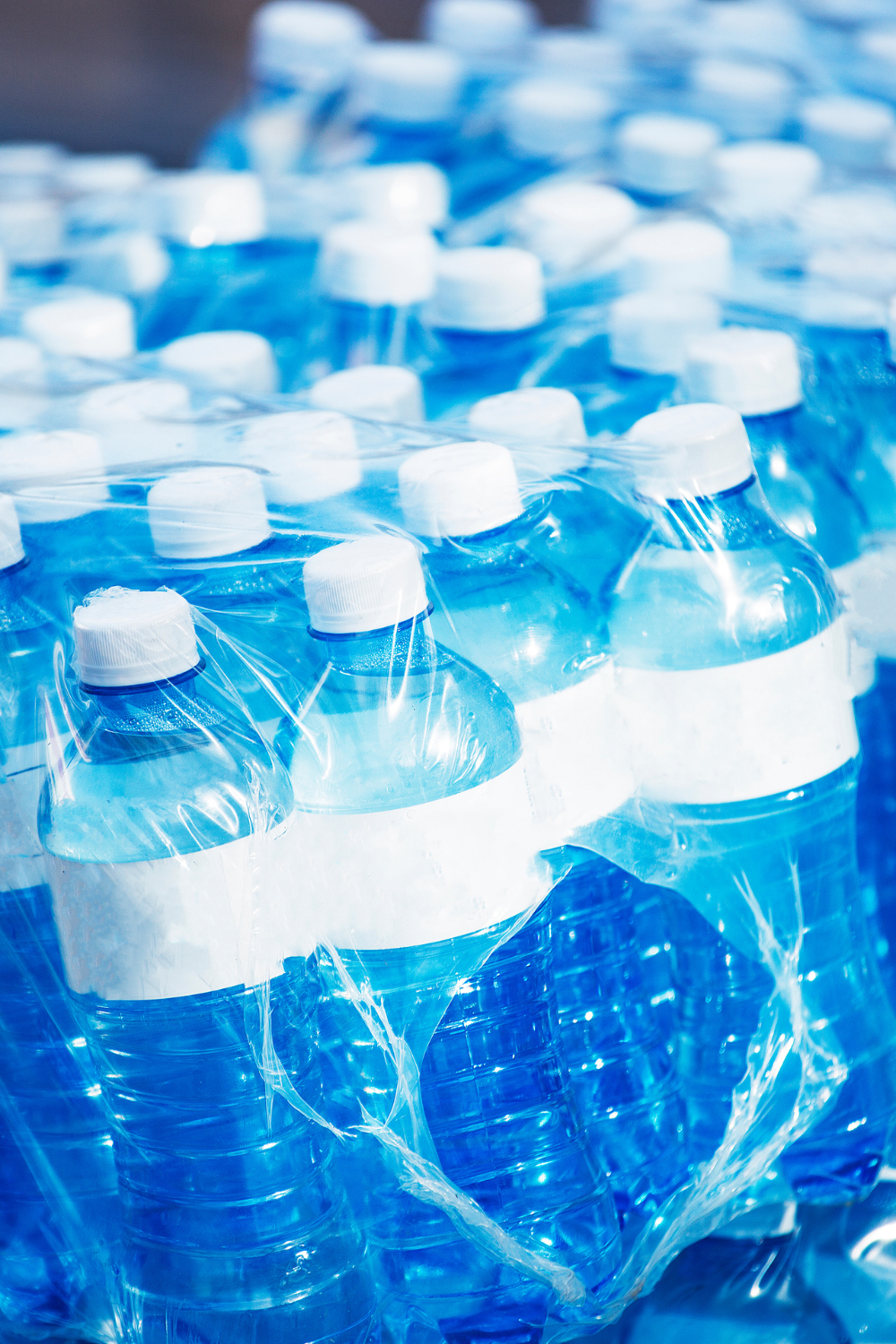
Determining the Minimum Water Requirement for Survival
When it comes to water, we all know that eight glasses a day keeps the doctor away. But in an emergency situation, your water requirements increase faster than a teenager’s data consumption on TikTok. The general rule of thumb is to stash away at least one gallon of water per person per day for drinking and sanitation needs. Think of it as your emergency water ration, and don’t be stingy with it – dehydration is not the look you want in a survival situation.
I like to stock up on those 40 packs of bottled water and stack them to the ceiling, creating a water tower. Each one of those 40 packs of 16-ounce water bottles is 5 gallons of water. Again, you need to stockpile one gallon of water per day per person. These 40 packs of bottled water are enough to provide water for one person for five days.
Factors Affecting Water Consumption in Crisis Situations
When it comes to water consumption in crisis situations, there are several factors that play a crucial role. Firstly, the availability of clean and safe water sources is paramount as individuals cannot consume contaminated water without risking their health. Secondly, the level of awareness and education about proper hygiene practices greatly influences water usage. People need to understand the importance of handwashing and use water efficiently for basic cleaning needs. Thirdly, climate conditions can impact water consumption in crisis situations. For instance, in hot and arid regions, individuals may require more water for hydration purposes compared to cooler areas.
Lastly, access to sanitation facilities, such as toilets and showers, affects water consumption as people need these amenities to maintain personal hygiene. Considering these factors is vital when addressing the complex issue of managing scarce resources during crises while ensuring the optimal well-being of affected populations.
Also, in a crisis, we tend to sweat a little more – it’s not just because of the heat; it’s the stress too. Physical exertion, heat, and humidity can leave you thirstier than normal. So, it’s important to consider these factors that can increase your water needs. Also, let’s not forget about the wee ones and the fur babies – they need their water too. So, when you’re calculating your water stash, remember to count every member of your squad.
Storing and Purifying Water for Emergency Use: Emergency Water Prep Tactics
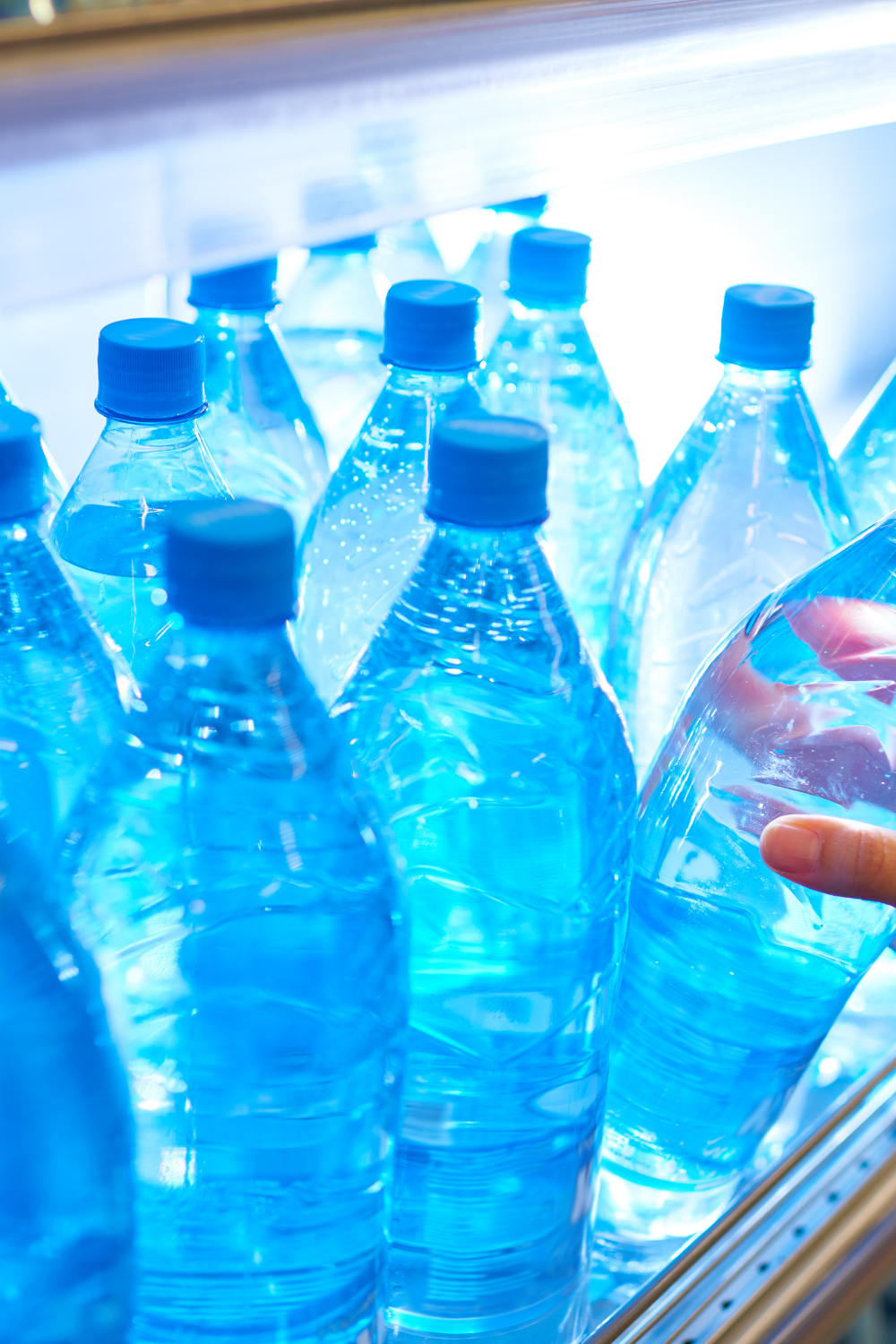
Choosing Appropriate Containers for Water Storage
Now that you know how much water you need, it’s time to find your water supply a cozy home. When it comes to storing water, not any container will do the trick. You’ll want containers that are food-grade, sturdy, and airtight like that trusty Tupperware your grandma still uses. Plastic or glass containers with tight-fitting lids are your best bet for keeping your water safe, clean, and free from any unwelcome surprises, preferably using containers meant for water storage.
When it comes to choosing appropriate containers for water storage, there are a few factors to consider. First and foremost, the material of the container is crucial. Plastic containers made of food-grade materials such as high-density polyethylene (HDPE) or polypropylene are recommended as they do not leach harmful chemicals into the water. Again, ensure that the chosen container has a tight-fitting lid to prevent any contaminants from entering. Yes, I had to keep enphasizing the importance of safe water storage!
Another important factor is size – consider your household’s water needs and choose a container with an adequate capacity. Transparency can also be valuable as it allows you to easily monitor water levels and potential contamination. Lastly, consider portability in case you need to move or transport the stored water during emergencies. Keeping these factors in mind will help you select suitable containers for storing water safely and efficiently.
Methods and Techniques for Water Purification
Sometimes, even your carefully stored water can get a little funky. So, it’s wise to have the means to purify water in case you’re dealing with contaminated sources. Boiling, filtering, or using water purification tablets can be your knight in shining armor in these situations.
When it comes to cleaning up water and making sure it’s safe for us to drink, there are a bunch of cool methods and techniques out there. One popular option is using activated carbon filters, which trap impurities like chemicals and bacteria as the water flows through them. Another method is reverse osmosis, where pressure pushes water through a semi-permeable membrane to remove all sorts of contaminants. We’ve also got UV disinfection, where ultraviolet light kills off harmful microorganisms in the water.
And let’s not forget about good ol’ boiling! Simply heating up water to its boiling point can do wonders in killing off bacteria and other nasties. Of course, these are just some of the many ways we can purify our water – each with its own pros and cons depending on the situation at hand.
Alternative Sources of Water in Crisis Scenarios: Emergency Water Prep Tactics
Identifying Potential Alternative Water Sources
When your regular water sources are elusive, it’s time to get creative. Nature can be your ally in finding alternative water sources. Rainwater, lakes, and rivers can provide you with a lifeline. Just make sure you’re not collecting water from hazardous or contaminated areas – you don’t want your survival efforts to go down the drain because you didn’t do your water quality check.
Sometimes we gotta think outside the box when it comes to quenching our thirst. One option is rainwater harvesting. Yep, you heard that right – collecting rainwater can be a real game changer. It involves capturing and storing rainfall for later use, whether it’s doing laundry or watering your plants. Another potential source is greywater recycling, which means reusing water from sinks, showers, and washing machines. Now don’t get all grossed out – greywater can be treated and used for non-potable purposes like flushing toilets or irrigation.
Also, we shouldn’t forget about desalination. This process involves removing salt and other impurities from seawater to make it drinkable. It may seem expensive and energy-intensive, but with advancements in technology, who knows what the future holds? So next time you’re pondering where to find H2O, remember these alternatives that just might save the day!
Assessing Water Quality and Safety: Emergency Water Prep Tactics
Assessing water quality and safety is crucial to ensuring the well-being of individuals and communities. When it comes to our drinking water, we want to be confident that what flows out of our taps is clean and free from harmful contaminants. To carry out this assessment, a series of tests are conducted to evaluate various parameters such as pH levels, turbidity, dissolved oxygen, and the presence of bacteria or chemicals. These tests are commonly performed by trained professionals or environmental agencies using sophisticated equipment and methodologies.
Additionally, regulatory authorities set guidelines and standards for acceptable water quality, enabling comparisons to identify potential issues or risks. It is important not only to regularly monitor the quality of drinking water, but also to address any concerns promptly through appropriate treatment methods. By doing so, we can significantly reduce the chances of water-related health problems and ensure a safe and refreshing beverage for all.
Not all water is created equal – some can be as safe as sipping lemonade on a sunny day, while others can be as dangerous as picking between clean water or poison with a blindfold. Before indulging in any water source, it’s crucial to assess its quality and safety. Look out for signs of contamination or pollutants, and consider using water treatment methods, like filtration or boiling, to ensure you’re not putting your health at risk. Remember, surviving an emergency is tough enough – you don’t need a bout of water-related illness to make it even more challenging.
Essential Water Prep Supplies and Tools
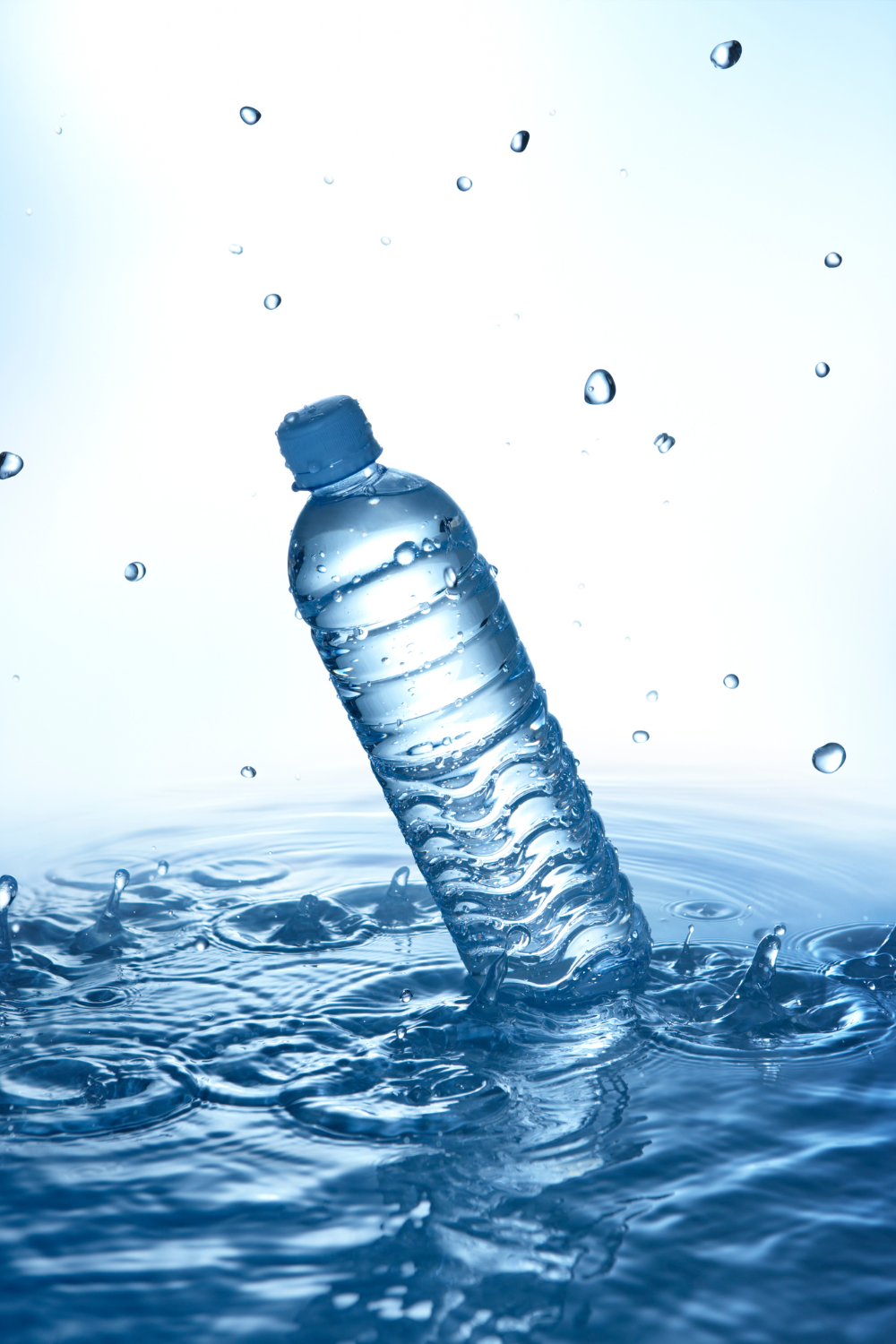
Must-Have Water Storage and Purification Equipment
When it comes to emergency water prep, having the right supplies and tools is crucial. Here are a few must-haves:
- Water Storage Containers: Invest in food-grade water storage containers that are sturdy and can hold a significant amount of water. Opt for containers with tight-fitting lids to prevent contamination.
- Water Purification Tablets or Filters: In an emergency, clean water sources may be scarce. Stock up on water purification tablets or filters to ensure you can safely drink water from questionable sources.
Additional Tools for Water Collection and Conservation: Emergency Water Prep Tactics
In addition to the essentials, consider adding these tools to your emergency water prep arsenal:
- Rain Barrels: Collecting rainwater can be an excellent way to supplement your water supply during an emergency. Invest in rain barrels and set them up to catch precious droplets from the sky.
- Drip Irrigation Systems: If you’re growing a survival garden or have plants that need watering, a drip irrigation system can help conserve water by delivering it directly to the plant’s roots. Plus, it saves you from doing the tricky math of “how much water is enough”.
Strategies for Conserving and Stretching Water Resources: Emergency Water Prep Tactics
Implementing Water Conservation Practices
In an emergency situation, every drop of water counts. Try these water conservation practices to make the most of your limited resources:
- Shorten Shower Time: Let’s be honest, the hot shower luxury might not be readily available in times of crisis. Take shorter showers or switch to the good old-fashioned sponge bath technique. Your water bill might thank you too!
- Fix Leaky Faucets: A small leak can add up to gallons of wasted water over time. Don’t let those annoying drips taunt you during a water shortage. Fix them promptly and save both water and your sanity.
Tips for Efficient Water Usage in Emergency Situations: Emergency Water Prep Tactics
During emergencies, efficient water usage becomes paramount. Here’s how you can stretch your water resources:
- Reuse Water: Don’t let any water go to waste. Collect water used for cooking, cleaning, or washing and repurpose it for non-potable purposes. Just make sure to label it clearly, so you don’t accidentally use it for drinking or cooking.
- Prioritize Hydration: When water is scarce, staying hydrated is vital. Conserve water by focusing on hydration essentials like drinking water and using small amounts for personal hygiene. Sorry, but those water-balloon fights might have to wait for a more hydrated day.
Ensuring Long-term Water Security in Emergency Situations
Creating a Comprehensive Water Management Plan
Planning ahead is key to ensuring long-term water security in emergencies. Consider these steps when creating your water management plan:
Assess Water Needs: Determine how much water you and your household will need during an emergency. Consider factors such as drinking, cooking, sanitation, and pet care. Remember, Fido gets thirsty too!
Identify Water Sources: Identify potential water sources in your area, such as lakes, rivers, or community wells. Research water quality and accessibility to assess their viability as emergency water sources.
Building Resilience through Sustainable Water Solutions: Emergency Water Prep Tactics
Building resilience means thinking beyond immediate needs. Consider these sustainable water solutions:
Rainwater Harvesting Systems: Install rainwater harvesting systems, such as cisterns or rain barrels, to capture and store rainwater for future use. Mother Nature can be quite generous when it comes to hydration, so take advantage!
Greywater Recycling Systems: Implement greywater recycling systems to reuse water from sinks, showers, and laundry for irrigation purposes. Who said emergency situations couldn’t have a touch of eco-friendly charm?
Training and Education for Effective Water Preparedness
Take Water Preparedness Training for Individuals and Communities
Knowledge is power, especially when it comes to water preparedness. Take training sessions and workshops for individuals and communities to enhance your water prep skills. Learn the art of hydration emergency water prep tactics!
Resources and Programs for Enhancing Water Preparedness Knowledge
Connect with people with resources and programs that can help enhance your water preparedness knowledge. This could include online courses, informative websites, or local community initiatives. Because let’s face it, being a water prep pro is a skill worth bragging about!
Conclusion
Remember, in emergency situations, water is a precious commodity. By having the right supplies, implementing water conservation strategies, and embracing sustainable solutions, you can quench your thirst for survival and ensure a more secure future. Stay hydrated, folks!
As we conclude this expert guide to emergency water prep tactics, it is essential to remember that water preparedness is not a one-time task, but an ongoing commitment to our safety and well-being. By implementing the strategies and techniques discussed in this article, you can better equip yourself and your loved ones to face unexpected situations with confidence.
Remember to regularly assess and update your water supplies, stay informed about local water resources, and share your knowledge with others in your community. With adequate water preparedness, we can navigate emergencies with resilience and ensure our survival. Stay safe, stay hydrated, and be prepared!
Frequently Asked Questions
1. How much water should I store for emergency situations?
It is recommended to store at least one gallon of water per person per day for a minimum of three days. However, the specific amount may vary depending on factors such as climate, age, health condition, and availability of alternative water sources.
2. What are some alternative sources of water during emergencies?
Alternative sources of water during emergencies can include rainwater collection, rivers or streams (if they are safe to access), and even melting ice or snow. However, it is crucial to purify or treat these water sources before consumption to ensure safety.
3. How long can stored water be kept for emergency use?
If properly stored, commercially bottled water can generally be kept for up to two years. However, it is advisable to regularly check the expiration dates and replace water containers if necessary. For tap water stored in clean containers, it is recommended to rotate and replace it every six months.
4. What are some water conservation tips during emergencies?
Water conservation is crucial during emergencies when resources may be limited. Some tips for conserving water include taking shorter showers, turning off taps when not in use, reusing water for various purposes (e.g., gardening, cleaning), and fixing any leaks as soon as possible.
Summary
I hope I have inspired you to live sustainably with these tips and products.
If you were encouraged by this post, I invite you to check out my FREE Printables Page for fun free printables, planners, and charts.
ENTER MY FREE Printables Page HERE
Here are some more of my gardening inspiration posts to check out!
Ideas for Rustic Living Room Vibes You’ll Love All Year Round!
How to Prep Your Home for Chilly Fall Nights
Bring Back the Magic of Fireflies and Lightning Bugs with Solar Power!
The Ultimate Portable Power Bank for Homesteaders and Preppers!
A Bug Out Bag That’s Actually Ready — When You Need It Most!
Magical Ways to Use Fairy Lights in Your Off-Grid Home
How to Live a Cozy Off-Grid Life
The Best Off-Grid Kitchen Tools for Indoors (No Power Needed!)
DIY Solar Made Simple: How I Powered My Off-Grid Life with Practical Preppers!
Sleeper Cells in America: What You Need to Know Now!
How People Are Surviving in Broken Cities with Broken Systems
When the World Hurts, We Prepare with Purpose
How to Live On Raw Land: Everything You Need to Know!
How to Do Off-Grid Laundry with Eco-Friendly Laundry Detergent!
Hollywood on Fire! What Secrets Are In the Ashes?
FEMA Concentration Camps? Are Echos of the Past Returning?
How Likely Is a Russian EMP? One Pulse Could Black Us Out!
What Dark Secrets Lie in The Bird Flu Symptoms?
The Blackout Sun: Who Is Blacking Out Our Sunlight?
More Posts!
How to Bug-In During a Deep Freeze!
‘FOGVID-24?’ What’s in the Mysterious Fog That’s Making Everyone Sick?
From Snow to Sow: Plan Your Spring Garden Now!
11 Fun Ways to Brighten Your Spring Garden with Personality
Top 10 Spring Garden Crops to Harvest in 30 Days and Eat Now!
The Best Survival Crops for Caloric Survival
More Posts!
My Victory Garden: What I Learned from 5+ Years
Why Every Family Should Have a Victory Garden in Their Backyard Now!
The Best Perennials for a Long-Term Survival Garden
The Best Essential Oils for Plants That Repel Garden Bugs
How to Grow Green Garden Peas: Perfect Plump Peas!
Hugelkultur: Does This Epic Pioneering Method Actually Work?
9 Ways to Celebrate Earthing Day in Your Garden!
Gardening Indoors: Secrets of Growing Your Food Inside!
How to DIY a Milk Jug Drip Irrigation System!
Why Cedar Mulch Is The Perfect Natural Weed Barrier
Gardening Projects
Onions: How to Grow Onions for Storage
Peas: How to Grow Garden Peas for a Bumper Crop
Carrots: How to Grow Carrots for a Bountiful Harvest
Prep Your Garden for Spring Planting with These Expert Tips!
How to Grow a Prepper Garden to Survive and Thrive
The Best Garden Tools You Need for a Productive Season
Fastest Growing Vegetables for Your Survival Garden
How to Grow Marigolds As Pest Control In Your Vegetable Garden
Must-Have Tools for a Successful Balcony Vegetable Garden
How to Effectively Combat Powdery Mildew in Your Garden
The Best Tips for Organic Gardening
How to Release Ladybugs In Your Garden for Organic Pest Control
More Posts!!
The Best Garden Snail Control Strategies
The Best Spring Vegetables to Grow in Your Garden
Seed Starter Mix: How To Make Your Organic Seed Starter Mix At Home
How to Grow a Productive Canning Garden
How to Plant and Grow a Salsa Garden
Easiest Heirloom Vegetable Seeds to Grow Now
How to Use the Hand Twist Claw Tiller: Tackling Tough Soil
More Fun Gardening Posts to Check Out!
Planning Your Garden: How to Plan a Vegetable Garden: Expert Green Thumb Tips!
Winterizing the Garden: How to Winterize Your Vegetable Garden: Step-by-Step Checklist
Mulching the Garden: How to Make Leaf Litter Mulch
Grow a Pumpkin Patch: How to Grow a Pumpkin Patch in Your Backyard
How to Grow a Fall Garden: 9 Best Fall Crops
Clever Ways to Incorporate Indoor Composting into Your Home
How to Start Composting for the Garden: A Step-by-Step Guide
The Ultimate Guide to Composting in Your Suburban Backyard
Why I Built A Survival Garden in My Backyard
16 Best Medicinal Herbs to Grow in Your Garden Now
Blessings,
The Off Grid Barefoot Girl




